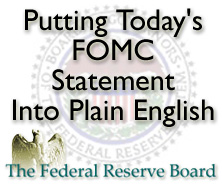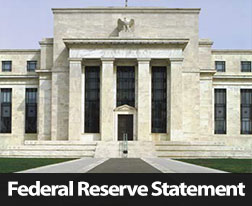 The minutes for the most recent meeting of the Federal Reserve’s Federal Open Market Committee (FOMC) suggest that while committee members won’t specify a date, a rate hike could come sooner than later. Committee members continue to cite concerns over labor markets and other economic factors, but the minutes of the FOMC meeting held July 28 and 29 indicate that a majority of members see a rate change as likely in the near term.
The minutes for the most recent meeting of the Federal Reserve’s Federal Open Market Committee (FOMC) suggest that while committee members won’t specify a date, a rate hike could come sooner than later. Committee members continue to cite concerns over labor markets and other economic factors, but the minutes of the FOMC meeting held July 28 and 29 indicate that a majority of members see a rate change as likely in the near term.
Economic Conditions “Approaching” Readiness for Rate Hike
According to the minutes released Wednesday, the time for raising rates is not hear yet, but a majority of FOMC members feel that the time is approaching when economic conditions will warrant an increase of the target federal funds rate which is currently set at 0.00 to 0.25 percent. When the Fed increases this rate, consumer loan rates including mortgage rates are expected to increase as well.
Achieving maximum employment is one of the Fed’s mandates; labor markets continue to improve as the national unemployment achieved its lowest reading for 2015 as of June, but labor force participation and the unemployment to population ratio have also declined. On a positive note, the number of part-time workers was lower and under-utilization of workers was lower than since the beginning of the year.
Committee members continued to have varied opinions about whether employment rates are low enough to indicate that the Fed’s mandate of “maximum” employment had been achieved.
Inflation remains below the 2.00 percent medium-term goal set by the Fed. FOMC members have consistently indicated that they don’t expect to see inflation achieve the target rate in the near term.
Housing Markets Show Improvement
The minutes noted that while construction of new homes declined in June, new starts increased over the second quarter. Sales of new homes were lower in June, but sales of existing homes increased. Building permits issued suggest the rate of construction is stable but little changed. Pending home sales were stable and suggest little change in completed home sales in the near term.
A jump in multifamily building permits were attributed to an expiring tax credit date, but housing analysts have repeatedly cited the millennial generation as preferring to live and work in large metro areas where housing can be out of reach for all but the top tier of earners. In other economic sectors, the minutes said that auto loans and student loans continued to grow.
The FOMC minutes indicate the same position of FOMC members in recent months; while the national unemployment rate is low, the Fed does not expect to see inflation at the agency’s target rate of 2.00 percent immediately. Committee members note that they will continue to monitor domestic and global financial conditions as part of the fact-finding process necessary for deciding when to the federal target funds rate,
Speculation over when the Fed will move to raise rates has persisted for several months and will no doubt continue until the Fed does decide to raise rates.
 Last week’s economic reports related to housing were few and far between other than weekly reports on new jobless claims and Freddie Mac’s mortgage rates survey.
Last week’s economic reports related to housing were few and far between other than weekly reports on new jobless claims and Freddie Mac’s mortgage rates survey.  This week’s scheduled economic news includes reports on construction spending, a survey of senior loan officers, and reports on labor markets including ADP private sector jobs, the federal government’s reports on non-farm payrolls, core inflation and the national unemployment rate.
This week’s scheduled economic news includes reports on construction spending, a survey of senior loan officers, and reports on labor markets including ADP private sector jobs, the federal government’s reports on non-farm payrolls, core inflation and the national unemployment rate. Last week’s scheduled economic reports included the Case-Shiller 20 and 20-City Index reports, pending home sales data released by the National Association of Realtors® and the scheduled post-meeting statement of the Federal Reserve’s Federal Open Market Committee.
Last week’s scheduled economic reports included the Case-Shiller 20 and 20-City Index reports, pending home sales data released by the National Association of Realtors® and the scheduled post-meeting statement of the Federal Reserve’s Federal Open Market Committee. The stage was set in high suspense for FOMC’s post-meeting announcement on Wednesday. As fall approaches, analysts and the media are looking for any sign of when and how much the Fed will raise its target federal funds rate. According to CNBC, some analysts were projecting two interest rate hikes before year end, but the truth of the matter remains unknown until the Federal Open Market Committee announces its intentions.
The stage was set in high suspense for FOMC’s post-meeting announcement on Wednesday. As fall approaches, analysts and the media are looking for any sign of when and how much the Fed will raise its target federal funds rate. According to CNBC, some analysts were projecting two interest rate hikes before year end, but the truth of the matter remains unknown until the Federal Open Market Committee announces its intentions. Housing markets show continued signs of strengthening according to reports released on Wednesday. The National Association of Realtors® reported that sales of pre-owned homes rose to 5.49 million in June as compared to May’s revised reading of 5.32 million pre-owned homes sold and expected sales estimated at 5.42 million sales. Expectations were based on May’s original reading of 5.35 million sales. June’s reading was the highest since February of 2007. Readings for existing home sales are calculated on a seasonally adjusted annual basis.
Housing markets show continued signs of strengthening according to reports released on Wednesday. The National Association of Realtors® reported that sales of pre-owned homes rose to 5.49 million in June as compared to May’s revised reading of 5.32 million pre-owned homes sold and expected sales estimated at 5.42 million sales. Expectations were based on May’s original reading of 5.35 million sales. June’s reading was the highest since February of 2007. Readings for existing home sales are calculated on a seasonally adjusted annual basis. Last week’s economic news included an encouraging report from the National Association of Home Builders, whose housing market index held steady with a reading of 60 in July. This was the 13th consecutive month for readings over 50, which indicate that more builders are confident about housing markets than those who are not. July’s reading was noteworthy as it was the highest since November 2005 prior to the recession.
Last week’s economic news included an encouraging report from the National Association of Home Builders, whose housing market index held steady with a reading of 60 in July. This was the 13th consecutive month for readings over 50, which indicate that more builders are confident about housing markets than those who are not. July’s reading was noteworthy as it was the highest since November 2005 prior to the recession. Home builder confidence remained steady at the highest reading in almost ten years according to the National Association of Home Builders (NAHB) Wells Fargo Housing Market Index for July. The latest reading of 60 for the index was identical to expectations and June’s reading, which was revised to 60 from an initial reading of 59. The NAHB Wells Fargo Housing Market Index is based on readings of zero to 100 with readings over 50 indicating that a majority of home builders surveyed are confident about housing market conditions. July’s reading was the 13th consecutive month of readings above 50.
Home builder confidence remained steady at the highest reading in almost ten years according to the National Association of Home Builders (NAHB) Wells Fargo Housing Market Index for July. The latest reading of 60 for the index was identical to expectations and June’s reading, which was revised to 60 from an initial reading of 59. The NAHB Wells Fargo Housing Market Index is based on readings of zero to 100 with readings over 50 indicating that a majority of home builders surveyed are confident about housing market conditions. July’s reading was the 13th consecutive month of readings above 50.  Last week’s scheduled economic events were few due to the Independence Day holiday. Freddie Mac’s weekly survey of mortgage rates brought good news as mortgage rates fell across the board. The Federal Reserve released the minutes of its most recent Federal Open Market Committee (FOMC) meeting and weekly jobless claims rose.
Last week’s scheduled economic events were few due to the Independence Day holiday. Freddie Mac’s weekly survey of mortgage rates brought good news as mortgage rates fell across the board. The Federal Reserve released the minutes of its most recent Federal Open Market Committee (FOMC) meeting and weekly jobless claims rose.